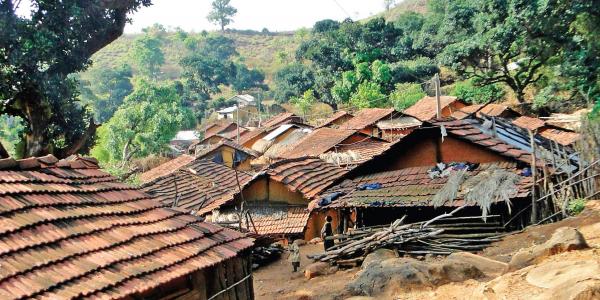The Lockdown Has Worsened the Plight of Odisha’s Indigenous Bonda Community
Women who are central to the Bonda economy, say that they cannot harvest forest produce and the local hats are closed. The lockdown has jeopardized not only their livelihoods but food and nutritional security as well.
Bondaghati (Odisha):
Perched on the southern edge of Odisha, in Malkangiri district, is the forested hill region of Bondaghati, home to one of the 13 Particularly Vulnerable Tribal Groups (PVTGs) in the state, namely the Bonda. They are believed to be part of the first wave of migration out of Africa, about 60,000 years ago.
The Bondas, who have had an intimate connection with the forest and the sustainable life it signified, have been affected by deforestation and changes in traditional farming practices for some time now. Collecting minor forest produce (MFP) partly for their use and partly for sale at the weekly haat is what has given them some cash income.
Due to their remote habitat, buyers or traders hardly visit Bonda villages to procure their harvested MFP. Therefore, it is at the local haats that most Bonda women sell their harvests. Some of the major forest produce they harvest for income generation, includes hill brooms; the siyali leaf, used for making plates; siyali seeds; siyali bark, used to make rope; and salap, a kind of mild alcoholic juice harvested from the salap tree mostly found in Bondaghati. Most of these products are perishable except for siyali bark which is mainly used to make rope. Berry varieties such as sindhikoli and chotodimbri are also harvested. They too are highly perishable.
The unprecedented situation brought upon by an extended lockdown has jeopardised the livelihoods, food and nutritional security of around 12,000 Bondas who live in 32 villages covering an area of around 130 square km, in Khairput block, as per the 2011 Census. According to tribal rights activists, “In the absence of urgent and pragmatic action by the state government, the situation can further worsen.”
Over the years, the Bondas have been seeing the yield from subsistence agriculture reducing. Subsequently, the income generated from selling surplus agro-produce has also reduced. Bonda women brew traditional liquor from millets, rice and jackfruit, selling it at the local haats, which provides them a steady flow of cash all year round. MFP and traditional liquor are critical sources of income generation for these communities – and both activities are out of bounds for them due to the lockdown.
Whether it is working on land, collecting MFP, or selling it in haats, women are central to the Bonda economy. It is they who talk about the impact of the lockdown on their existence. Budai, Chhanki and Sombari belong to the upper Bonda communities, which inhabit the villages located on the slopes of Bondaghati. They fall under the Mudulipada and Andrahal panchayat (the villages of all three fall under the former). Those who reside on the foothills of Bondaghati are known as the lower Bonda communities.
For the upper Bonda communities in particular, the impact of the closure of local haats has been catastrophic. “The local haat is the nerve centre of Bonda communities and the heart of their village economy,” says Sukesh Mridha, project coordinator with the Centre for Youth and Social Development, a nonprofit organisation, in Malkangiri. The haats are not significant for their economic aspect alone; they also provide a space for the reclusive Bonda people to communicate with each other, share ideas, news and information, Mridha explains. Several local civil society organisations, even the authorities, have on occasion conducted sensitization programmes at the weekly haats to ensure a wider outreach of key information for the Bonda communities.
The lockdown has made the task of disseminating vital information on COVID-19 among the Bonda communities a daunting challenge. PDS bottlenecks
According to civil society organisations, about 70% of Bonda households are covered under the public distribution system (PDS). Santosh Sukla, secretary of Parivartan, a not-for-profit organisation working with the indigenous communities in Malkangiri, explains the reasons why several Bonda households are excluded from the PDS.
“Non-linkage of Aadhar with ration cards have deprived the Bonda people of PDS supplies, and some people have lost their cards, too,” says Sukla. In the case of many Bondas, the names on their ration cards are not exactly the same as in their Aadhar cards, and that prevents them from accessing the PDS.
“Although the state government has recently announced that every household will get PDS rations, even those who don’t have Aadhar cards, local authorities are not paying heed to it, says Sukla.
However,those who have their PDS cards have received ration for three months from the government. In order to address the bottlenecks in the PDS system, a Skype interaction was conducted with Minister of Food Supplies and Consumer Welfare Co-operation, Ranendra Pratap Swain. The interaction was organised by Vasundhara, a not-for-profit organisation in Bhubaneswar, working with the indigenous communities on issues of lands rights, forest governance and livelihood development. The issue of food and nutritional security However, development practitioners from the region believe that accessing PDS food supplies is not sufficient to holistically address the issues of food and nutritional securities among the Bonda people.
“Their nutritional intake is far below the accepted standard,” says Rajesh Pattanayak, district project officer, Public Health Resource Society (PHRS), a not-for-profit organisation working with the Bonda and forest dwelling communities, on promoting food security and access to better healthcare
services in Malkangiri. Pattanayak has several reasons for holding this view. Since the Bondas depend on rain-fed agriculture, access to nutritional food in the off-season depends on the quantum of harvest and income raised from selling forest produce gathered mostly by women.
Due to the variation in rain, temperature and soil moisture, the Bondas have consistently reported substantial yield reduction of their traditional crops such as millets, pulses and cereals lately. Clearly, the pandemic and the lockdown induced by it has exposed long-standing issues regarding the nature of engagement that the state and civil society organisations need to have with the remote Bonda communities. Engagement cannot be a euphemism for one-way communication. It needs to be a conversation which pays heed to their voices and worldview and paves the way for interventions ensuring their livelihoods, food and nutritional security, and cultural confidence.
The Lockdown Has Worsened the Plight of Odisha’s Indigenous Bonda Community
👉 Join: VISHNU IAS ACADEMY FOR UPSC CSE for an update
👉 Join: AnthroMaster for Anthropology updates
👉 Join: General Studies Prelims and Mains 2020&2021 for updates
👉 Join: Anthropology Discussion for Anthropology doubts.



